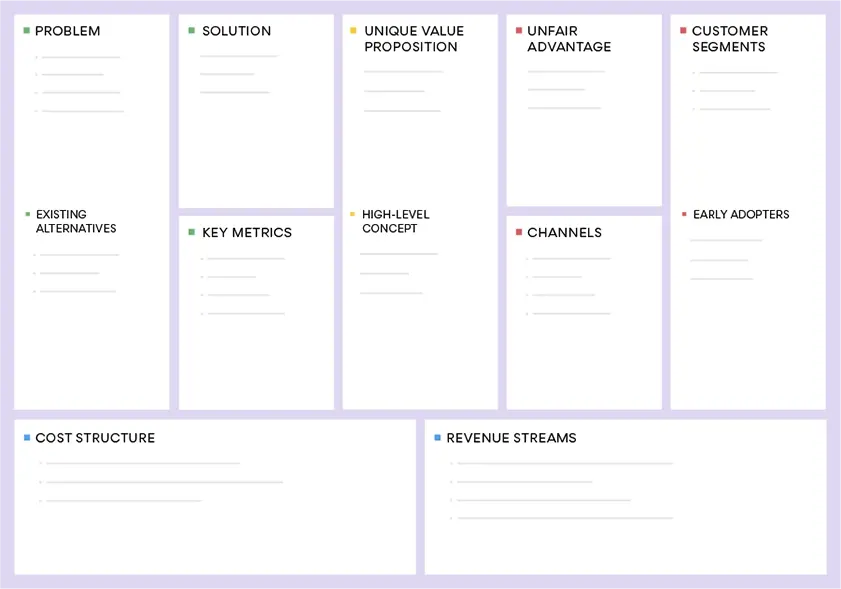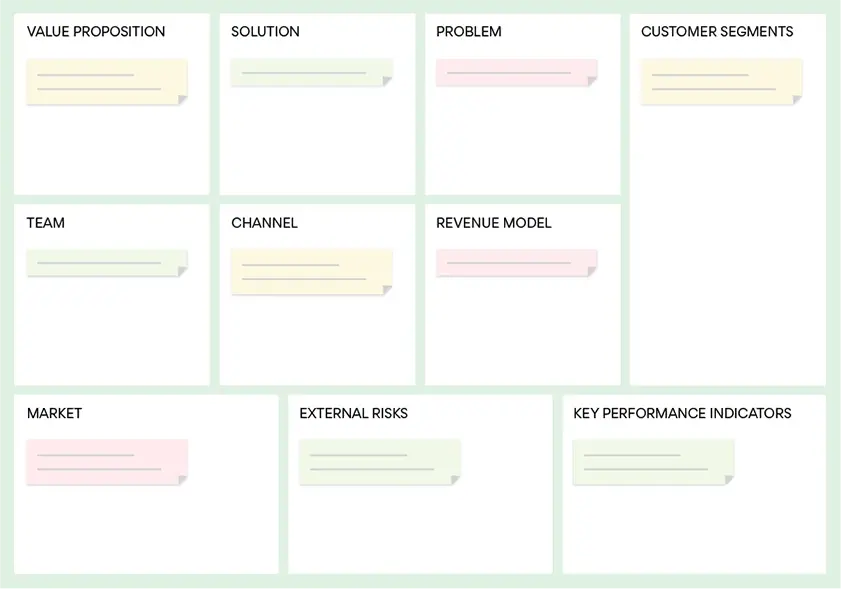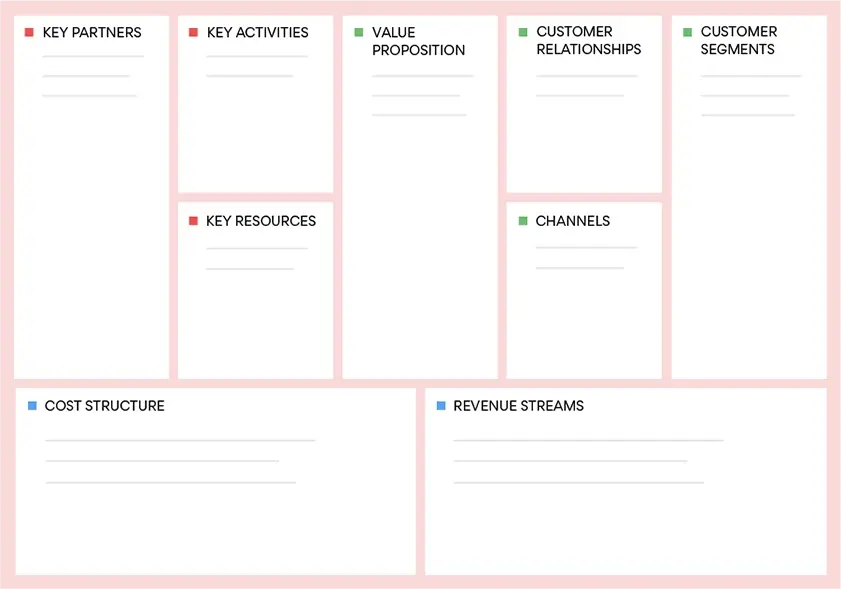Many entrepreneurs find it challenging to put their business ideas on paper. So don’t worry if you’re feeling the same anxiety.
The solution? Try starting with a one-page business plan!
This simple yet powerful tool helps you and your audience gain a clear understanding of your business.
But how do you write one—this guide will walk you through the process of creating a one-page business plan, including its types, essential components, and business plan templates.
Thus, let’s get started on crafting an effective plan. But before that let’s go through what it is.
What is a one-page business plan?
A one-page business plan is a simple and shorter version of a traditional business plan. It outlines the necessary elements of your business, such as the problem, solution, target customers, financial analysis, and other important things on a single page.
It’s specifically made to provide a quick idea of the business’s concept for easy communication and updates when needed.
Traditional vs. one-page business plan
A traditional business plan is a detailed document of around 15 to 30 pages. It covers everything from business overviews to financial forecasts in different sections. Whereas the one-page business plan is a single-page plan that’s a condensed version of the whole plan.
Traditional business plans are perfect if you need to secure significant funding or map out long-term strategies for your business.
On the other hand, a one-page business plan is ideal for quickly sharing your business idea and internal use for strategic planning. It’s concise and easy to update, making it perfect for startups and small businesses that need to stay updated and focused.
Now that we know the difference, let’s move forward to the components of the one page business plan.
What to include in your one-page business plan
A one-page business plan is particularly designed to provide a brief overview of your business, including your business idea, goals, strategies, and key metrics.
Here are the sections you need to include:
1. Problem
Note and mention the problems of the target customers that your product or service will solve. This is the part where you should create a convincing statement that’s relatable for your readers.
2. Customers
Identify who your target customers are, including their behaviors and demographics. Explain how your business will meet this specific target market’s needs.
3. Market
Here, include information on market size, growth potential, and key trends. Highlight the demand for your product or service within this market.
4. Competitors
Highlight your main competitors along with their strengths and weaknesses. Explain how your business will stand out in the competitive landscape. Discuss any gaps in the market that your business will fill.
5. Solution
Explain your solution here about how your product or services will solve the problem. Also, highlight why your solution is the best fit for your audience.
6. Product
Detail what exactly you offer to your audience and what’s the unique value proposition of the product or service. Also, mention how your product stands out along with your competitive advantage.
7. Team
Introduce key members of your business, highlighting their roles and responsibilities. Also, add up their relevant experience and expertise in the industry.
8. Promotion
Outline your strategies—including a marketing plan, social media strategies, and advertising plans. Explain how these strategies will attract and retain customers.
9. Distribution
Describe the distribution channels you will use, such as online or retail stores, or direct delivery. Mention any partnerships with distributors that reach your target market.
10. Partners
Identify key business partners or collaborators who will play a crucial role in your business’s success. This could include suppliers or strategic alliances. Explain how these partnerships will support your business operations and growth.
11. Financing
Summarize your financial projections, including expected revenue, expenses, and profitability. Outline your funding requirements, specifying how much money you need to start or grow your business and what it will be used for.
12. Startup costs
Provide the list and estimation of the initial costs required to start your business. It includes costs for equipment, inventory, marketing, and any other significant startup expenses.
13. Running costs
Detail the ongoing operational costs necessary to run your business. This could include salaries, rent, utilities, supplies, and maintenance expenses.
14. Revenue streams
Clearly outline each revenue stream and how it contributes to your overall financial goals. List the different revenue streams, for example: product sales, subscription fees, licensing, or other sources of income.
Now that you know all the sections that need to be included in the one-page plan, let’s see which templates are used commonly.
Simplify your business plan writing journey
Create one-page business plan with AI in minutes
Plans starting from $14/month

Most common one-page business plan templates
There are various types of one-page business plans with different components, let’s see them one by one:
1. One-page business plan canvas
The one-page business plan canvas helps businesses maintain the strategic overview of their company. By including all the necessary elements, it ensures everyone is in sync with the company’s mission and goals.
This is the one-page business plan canvas by Upmetrics:

2. One-page business plan: lean canvas
The lean canvas is ideal for startups and early-stage businesses to test their business concept. It helps the team focus on solutions and validate their business model through continuous feedback and learning.

3. One-page business plan: startup canvas
This canvas is for entrepreneurs to communicate their business ideas. It helps new entrepreneurs rapidly capture their business concepts, ensuring everyone understands the key elements and direction.

4. One-page business model canvas
The business model canvas is to help businesses visualize their entire business model on one page. It showcases how the business creates and delivers value.

How to use the one-page business plan template
You see it’s quite easy to use any of our one-page canvas templates. All you need to do is—download the template (we support PPTX and PDF format) and start filling in the details.
To begin with, gather the relevant business information; details on your target market, market research, and other essential points. Read the tips under each section to understand what to write, and begin filling out all sections.
Since you’re doing it all on your own, it may take a while to get things done. However, if you choose to use Upmetrics’ strategic planning tool, things can be sped up. Simply enter some related business information, and the Upmetrics AI assistant will do the rest.
The Quickest Way to turn a Business Idea into a Business Plan
Fill-in-the-blanks and automatic financials make it easy.
Prepare your one-page business plan using AI
While traditional planning methods still exist and work, I’d be hard-pressed to believe they’re as efficient as AI-powered tools.
Ideating a one-page plan is more about brainstorming, guess working, and critical thinking, than writing.
Considering the importance of a one-page plan for your business, your stretched-out schedules, and other critical tasks on your to-do, using an AI-powered tool like Upmetrics for planning seems your best bet.
A strategic planning tool for one-page plans, a plan builder for detailed plan creation, a pitch deck creator for compelling investor decks, and an AI-powered financial forecasting tool for accurate forecasts, Upmetrics has all you need once you finish your plan.
So, what’s the wait? Try Upmetrics and start preparing your one-page plan.



